
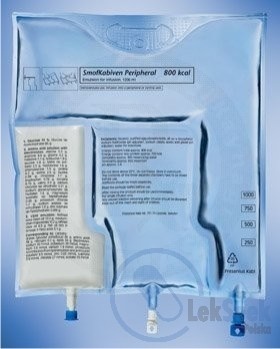
Smofkabiven Peripheral

Ask a doctor about a prescription for Smofkabiven Peripheral

How to use Smofkabiven Peripheral
Leaflet accompanying the packaging: information for the user
SmofKabiven Peripheral, infusion emulsion
Read the leaflet carefully before using the medicine, as it contains
important information for the patient.
- Keep this leaflet, you may need to read it again.
- In case of any doubts, consult a doctor, pharmacist or nurse
- If the patient experiences any side effects, including any side effects not listed in this leaflet, tell your doctor, pharmacist or nurse. See section 4.
Table of contents of the leaflet
- 1. What SmofKabiven Peripheral is and what it is used for
- 2. Important information before using SmofKabiven Peripheral
- 3. How to use SmofKabiven Peripheral
- 4. Possible side effects
- 5. How to store SmofKabiven Peripheral
- 6. Contents of the packaging and other information
1. What SmofKabiven Peripheral is and what it is used for
SmofKabiven Peripheral is an infusion emulsion administered to the patient through a drip (intravenous infusion).
The packaging of the medicine consists of a plastic bag containing amino acids (essential for protein production), glucose (carbohydrates), fats (lipids) and salts (electrolytes). The medicine can be used in adults and children over 2 years of age.
SmofKabiven Peripheral is administered by medical professionals when other methods of nutrition are insufficient or impossible.
2. Important information before using SmofKabiven Peripheral
Do not use SmofKabiven Peripheral if the patient has:
- hypersensitivity to the active substances or to any of the other components of this medicine (listed in section 6);
- allergy to fish protein or egg;
- allergy to peanuts or soy (SmofKabiven Peripheral contains soybean oil);
- too high a level of fats in the blood (hyperlipidemia);
- severe liver function disorders;
- blood coagulation problems (coagulation disorders);
- amino acid metabolism disorder;
- severe kidney disease, without the possibility of dialysis;
- acute shock;
- uncontrolled, increased blood glucose levels (hyperglycemia);
- increased levels of any of the electrolytes contained in SmofKabiven Peripheral in the blood (serum);
- fluid in the lungs (acute pulmonary edema);
- too much fluid in the body (overhydration);
- untreated heart failure;
- hemophagocytic syndrome (a disorder of the blood clotting system);
- unstable general condition, e.g. severe post-traumatic condition, uncontrolled diabetes, acute myocardial infarction, stroke, thrombosis, metabolic acidosis (a condition characterized by too much acidic substance in the blood), severe infection (severe sepsis), coma, fluid deficiency (hypotonic dehydration). SmofKabiven Peripheral should not be used in children under 2 years of age.
Warnings and precautions
Before starting SmofKabiven Peripheral, discuss with your doctor if the patient has:
- kidney disease;
- diabetes;
- pancreatitis;
- liver disease;
- hypothyroidism (thyroid disorders);
- sepsis (severe infection).
If during infusion fever, rash, swelling, difficulty breathing, chills, sweating, nausea or vomiting occur, immediately inform the medical staff, as these symptoms may be caused by an allergic reaction or too high a dose of the medicine.
The doctor may recommend regular blood tests to determine liver function tests and other values.
Children and adolescents
SmofKabiven Peripheral is not intended for administration to newborns or children under 2 years of age. SmofKabiven Peripheral can be administered to children from 2 to 16/18 years of age.
SmofKabiven Peripheral and other medicines
Tell your doctor about all medicines the patient is currently taking or has recently taken, as well as medicines the patient plans to take, including those available without a prescription.
Pregnancy and breastfeeding
There are no data on the use of SmofKabiven Peripheral during pregnancy or breastfeeding. SmofKabiven Peripheral is administered to pregnant or breastfeeding women only if the doctor considers it necessary. SmofKabiven Peripheral during pregnancy and breastfeeding may be administered on the doctor's instructions.
Driving and using machines
Not applicable, as SmofKabiven Peripheral is used in a hospital.
3. How to use SmofKabiven Peripheral
This medicine should always be used as directed by your doctor. In case of doubts, consult your doctor.
The doctor selects an individual dose based on the patient's body weight and clinical condition.
SmofKabiven Peripheral is administered only by medical professionals.
Using a higher dose of SmofKabiven Peripheral than recommended
It is unlikely that the patient will receive too high a dose of SmofKabiven Peripheral, as the medicine is administered by medical professionals.
4. Possible side effects
Like all medicines, this medicine can cause side effects, although not everybody gets them.
Common side effects(may occur in up to 1 in 10 patients): slight increase in body temperature, inflammation of the superficial veins at the infusion site.
Uncommon side effects(may occur in up to 1 in 100 patients): high levels of liver enzymes in the blood, loss of appetite, nausea, vomiting, chills, dizziness and headaches.
Rare side effects(may occur in up to 1 in 1000 patients): low or high blood pressure, difficulty breathing, rapid heart rate (tachycardia). Allergic reactions (which may cause symptoms such as swelling, fever, drop in blood pressure, rash, blisters, redness, headache). Feeling hot and cold. Paleness. Slight cyanosis of the lips and skin (related to hypoxia). Neck, back, bone, chest and lumbar pain.
Reporting side effects
If any side effects occur, including any side effects not listed in this leaflet, tell your doctor, pharmacist or nurse. Side effects can be reported directly to the Department of Adverse Reaction Monitoring of Medicinal Products, Medical Devices and Biocidal Products
Al. Jerozolimskie 181C, 02-222 Warsaw
tel.: +48 22 49 21 301, fax: +48 22 49 21 309
website: https://smz.ezdrowie.gov.pl
Side effects can also be reported to the marketing authorization holder.
By reporting side effects, you can help provide more information on the safety of this medicine.
5. How to store SmofKabiven Peripheral
Store the medicine out of sight and reach of children.
Do not store above 25°C. Do not freeze. Store in the outer bag.
Do not use this medicine after the expiry date stated on the bag and carton. The expiry date refers to the last day of the month stated.
6. Contents of the packaging and other information
What SmofKabiven Peripheral contains
The active substances of the medicine are:
per 1000 ml
glucose (monohydrate)
alanine
71
4.4
arginine
3.8
glycine
3.5
histidine
0.93
isoleucine
1.6
leucine
2.3
lysine (as acetate)
2.1
methionine
1.3
phenylalanine
1.6
proline
3.5
serine
2.1
taurine
0.32
threonine
1.4
tryptophan
0.63
tyrosine
0.12
valine
2.0
calcium chloride (as dihydrate)
0.18
sodium glycerophosphate (as hydrated)
1.3
magnesium sulfate (as heptahydrate)
0.38
potassium chloride
1.4
sodium acetate (as trihydrate)
1.1
zinc sulfate (as heptahydrate)
0.004
purified soybean oil
8.5
triglycerides of saturated fatty acids with medium chain length
8.5
purified olive oil
7.0
fish oil rich in omega-3 fatty acids
4.2
The other ingredients (excipients) are: glycerol, purified egg phospholipids, all-rac-α-tocopherol, sodium hydroxide (for pH adjustment), sodium oleate, glacial acetic acid (for pH adjustment) and water for injections.
What SmofKabiven Peripheral looks like and what the pack contains
The glucose and amino acid solutions are clear, colorless to slightly yellow, particle-free. The fat emulsion is white and homogeneous.
Pack sizes:
1 × 1206 ml, 4 × 1206 ml
1 × 1448 ml, 4 × 1448 ml
1 × 1904 ml, 4 × 1904 ml
Not all pack sizes may be marketed.
Marketing authorization holder and manufacturer
Marketing authorization holder
Fresenius Kabi AB
SE-751 74 Uppsala
Sweden
Manufacturer
Fresenius Kabi Austria GmbH
Hafnerstrasse 36
8055 Graz
Austria
Fresenius Kabi AB
SE-751 74 Uppsala
Sweden
To obtain more detailed information, please contact the representative of the marketing authorization holder:
Fresenius Kabi Polska Sp. z o.o.
Al. Jerozolimskie 134
02-305 Warsaw
tel.: +48 22 345 67 89
Date of last revision of the leaflet:01.06.2023
---------------------------------------------------------------------------------------------------------------------------
Information intended for healthcare professionals only:
Warnings and precautions for use
In order to avoid the risks associated with infusion at a rate higher than recommended, it is recommended to perform it continuously and under appropriate control, if possible using a volumetric pump.
Since the use of a peripheral vein for infusion is associated with an increased risk of infection, when inserting and handling the catheter, it is recommended to strictly follow the principles of aseptic procedure to avoid any infection.
It is also recommended to monitor glucose and electrolyte levels in serum, osmolality and fluid balance and acid-base balance, as well as to perform liver function tests.
In case of any signs or symptoms of anaphylactic reaction (such as fever, chills, rash or shortness of breath), the infusion should be stopped immediately.
SmofKabiven Peripheral should not be administered simultaneously with blood in the same infusion set, due to the risk of pseudoagglutination.
In case of peripheral vein infusion, there is a possibility of phlebitis. The infusion site should be checked daily for local signs of phlebitis.
Method of administration
Intravenous administration, infusion into a peripheral or central vein.
In order to ensure complete parenteral nutrition, it is recommended to add micronutrients, vitamins and, if necessary, electrolytes (taking into account the electrolytes already present in the SmofKabiven Peripheral bag) to the medicine, according to the patient's needs.
Dosage
Adult patients
Recommended dosage
The dose range is from 20 to 40 ml of SmofKabiven Peripheral/kg body weight/day, which provides from 0.6 to 1.3 g of amino acids/kg body weight/day (corresponding to 0.10 to 0.20 g of nitrogen/kg body weight/day) and from 14 to 28 kcal/kg body weight/day of total energy (from 11 to 22 kcal/kg body weight/day of non-protein energy).
Infusion rate
The maximum infusion rate of glucose is 0.25 g/kg body weight/hour, amino acids 0.1 g/kg body weight/hour, and fats 0.15 g/kg body weight/hour.
The infusion rate should not exceed 3.0 ml/kg body weight/hour (corresponding to 0.10 g of amino acids, 0.21 g of glucose and 0.08 g of fat/kg body weight/hour). The recommended infusion time is from 14 to 24 hours.
Maximum daily dose
The maximum daily dose depends on the patient's clinical condition and may change even from day to day. The recommended maximum daily dose is 40 ml/kg body weight/day.
Children and adolescents
Children aged 2-11 years
Recommended dosage
The dose of up to 40 ml/kg body weight/day should be regularly adjusted to the requirements of the pediatric patient, which may vary significantly more than in adult patients.
Infusion rate
The recommended maximum infusion rate is 3.0 ml/kg body weight/hour (corresponding to 0.10 g of amino acids/kg body weight/hour, 0.21 g of glucose/kg body weight/hour and 0.08 g of fat/kg body weight/hour).
The recommended infusion time is from 12 to 24 hours.
Except in special cases, when using the maximum recommended daily dose, the infusion time should not be less than 13 hours to avoid exceeding the maximum infusion rate.
Maximum daily dose
The maximum daily dose is variable depending on the patient's clinical condition and may change even from day to day. The recommended maximum daily dose is 40 ml/kg body weight/hour.
Adolescents aged 12-16/18 years
In adolescents, SmofKabiven Peripheral can be dosed as in adult patients.
Special precautions for disposal and preparation of the medicine for use
Do not use if the packaging is damaged.
Use only if the amino acid and glucose solutions are clear, colorless to slightly yellow, and the fat emulsion is white and homogeneous. The contents of the three separate chambers should be mixed before use and before adding any other substances through the dedicated port.
After removing the protective covers, turn the bag over several times to mix all the components of the medicine thoroughly and obtain a homogeneous mixture in which no signs of phase separation are visible.
For single use only. Any unused medicine remaining after infusion should be disposed of.
Compatibility
Compatibility data are available for Dipeptiven, Addamel N/Supliven, Glycophos, Addiphos, Vitalipid N Adult/Infant and Soluvit N in specified quantities and electrolyte concentrations. When adding electrolytes, their quantities already present in the bag should be taken into account to meet the patient's clinical needs. Available data confirm the possibility of adding the above-mentioned medicines to the activated bag in accordance with the table below:
Compatibility range: stable for 7 days, i.e. 6 days stored at a temperature of 2-8 °C, and then 24 hours at a temperature of 20-25 °C.
| Unit | Maximum total content | |||
| SmofKabiven Peripheral bag size | ml | 1206 | 1448 | 1904 |
| Supplement | Volume | |||
| Dipeptiven | ml |
|
|
|
| Supliven/Addamel N | ml |
|
|
|
| Soluvit N | vial |
|
|
|
| Vitalipid N Adult/Infant | ml |
|
|
|
| Limits of electrolytes | Quantity per bag | |||
| Sodium | mmol | ≤ 180 | ≤ 225 | ≤ 300 |
| Potassium | mmol | ≤ 180 | ≤ 225 | ≤ 300 |
| Calcium | mmol | ≤ 6 | ≤ 7.5 | ≤ 10 |
| Magnesium | mmol | ≤ 6 | ≤ 7.5 | ≤ 10 |
| Inorganic phosphate (Addiphos) or organic phosphate (Glycophos) | mmol | ≤ 18 | ≤ 22.5 | ≤ 30 |
| Zinc | mmol | ≤ 0.2 | ≤ 0.25 | ≤ 0.3 |
| Selenium | μmol | ≤ 1 | ≤ 1 | ≤ 1 |
Note: This table is intended to demonstrate compatibility. It does not provide dosing guidelines. Before prescribing the above-mentioned medicines, read the approved package leaflets.
Information on compatibility with other additives and storage times of different mixtures is available on request.
Any additives should be combined with the medicine under aseptic conditions.
Shelf life after mixing the contents of the bag chambers
Physical and chemical stability of the mixed contents of the triple-chamber bag has been demonstrated for 48 hours at a temperature of 20-25 °C. From a microbiological point of view, the medicine should be used immediately. Otherwise, the user is responsible for the storage period during use and the storage conditions before use. This period should not exceed 24 hours at a temperature of 2-8 °C, unless mixing took place in controlled and validated aseptic conditions.
Shelf life after mixing with additional substances
Physical and chemical stability of the mixed contents of the triple-chamber bag with additional substances has been demonstrated for up to 7 days, i.e. 6 days at a temperature of 2-8 °C, and then 24 hours at a temperature of 20-25 °C, including the infusion time. From a microbiological point of view, the medicine should be used immediately after adding other components. Otherwise, the user is responsible for the storage period during use and the storage conditions before use. This period should not exceed 24 hours at a temperature of 2-8 °C, unless mixing took place in controlled and validated aseptic conditions.
SmofKabiven Peripheral Instructions for preparing the bag for use
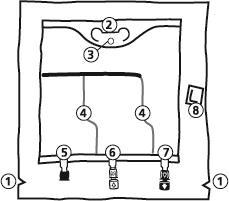
- 1. Notch in the outer bag
- 2. Bag handle
- 3. Hole for hanging the bag
- 4. Welds separating the individual chambers of the bag
- 5. Blind port (used only in production)
- 6. Port for administering additional substances
- 7. Infusion port
- 8. Oxygen absorber
1. Removing the outer bag
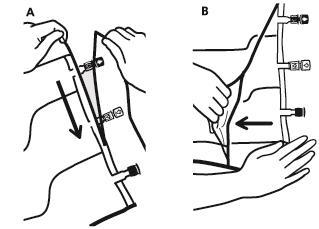 | |
| Then tear the outer bag along the long edge, remove it and discard it together with the oxygen absorber (B). | |
| |
2. Mixing

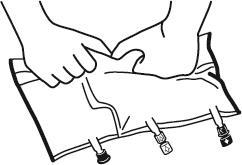

- Place the bag on a flat surface.
- Starting from the handle side, roll the bag firmly towards the ports, first with the right hand and then, applying constant pressure, with the left hand, until the vertical welds burst. They open under the pressure of the liquid. The welds can also be opened before removing the outer bag. Note: the liquid mixes easily, even though the horizontal weld remains intact.
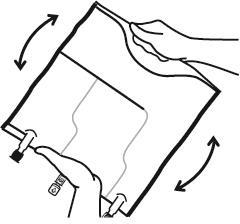
- Mix the contents of the three chambers by turning the bag over three times, which should ensure thorough mixing of the components.
3. Final preparation steps
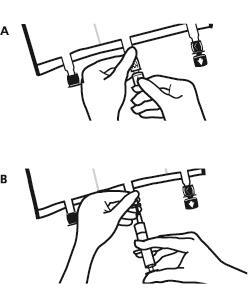
- Place the bag on a flat, even surface. Just before adding other substances, remove the labeled plug from the white port for administering additional substances (A). Note: the membrane of the port for administering additional substances is sterile.
- Hold the base of the port for administering additional substances. Insert the needle and inject the additional substances (with known compatibility) through the center of the injection site (B).
- Mix the contents of the bag thoroughly after adding each component by turning the bag over three times after each addition. Use syringes with needles with a diameter of 18 to 23 G and a maximum length of 40 mm.

- Just before connecting the infusion set, remove the plug from the blue infusion port (A). Note: the membrane of the infusion port is sterile.
- Use infusion sets without an air vent or close the air vent.
- Hold the base of the infusion port.
- Insert the spike of the infusion set into the infusion port. To ensure good fixation of the spike, insert it to its full length. Note: the inner surface of the infusion port is sterile.
4. Hanging the bag
 | |
- Hang the bag using the hole located below the handle.
- Country of registration
- Active substance
- Prescription requiredNo
- Manufacturer
- ImporterFresenius Kabi AB Fresenius Kabi Austria GmbH
- This information is for reference only and does not constitute medical advice. Always consult a licensed doctor before taking any medication. Oladoctor is not responsible for medical decisions based on this content.
- Alternatives to Smofkabiven PeripheralDosage form: Solution, -Active substance: combinationsPrescription not requiredDosage form: Solution, -Active substance: combinationsPrescription not requiredDosage form: Solution, -Active substance: combinationsPrescription not required
Alternatives to Smofkabiven Peripheral in other countries
The best alternatives with the same active ingredient and therapeutic effect.
Alternative to Smofkabiven Peripheral in Spain
Alternative to Smofkabiven Peripheral in Ukraine
Online doctors for Smofkabiven Peripheral
Discuss dosage, side effects, interactions, contraindications, and prescription renewal for Smofkabiven Peripheral – subject to medical assessment and local rules.














